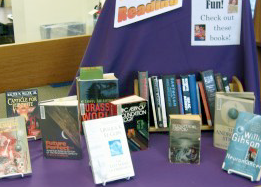 November 2011
November 2011
Mary Shelly
Imagine an alternate universe where Mary Shelly did not take a trip to Geneva, Switzerland. Because she did not take this trip she never thought of or wrote Frankenstein. Now imagine our culture without Frankenstein’s monster. Abbot and Costello never meet him (Abbot and Costello Meet Frankenstein – 1948); Kenneth Branagh never creates him (Frankenstein – 1994); Mel Brooks and Gene Wilder never spoof him (Young Frankenstein – 1974). Halloween and The Munsters also seem to be missing a vital character. Mary Shelly is said to be the first science fiction author, helping shape the way for other women in a male dominated genre. Her legendary monster has also shaped much of our pop culture. Her creation has spawned
dozens of movies and plays and inspired artists, authors, and those in costume.
Clare Wiggins Harris
Did you know that the author who is now recognized as a pioneer of women authoring science fiction was the first woman to publish her writings in science fiction magazines under her own name and helped to shape the cyborg mythology? Captain Jean-Luc Picard should tip his hat to Clare Wiggins Harris, author of many science fiction short stories published in the 1920’s and 1930’s. Her most famous story The Miracle of the Lily, published in 1928, may have
originated the now popular sci-fi/cyborg question and theme, “What is human?”
Other Authors
If you are interested in reading science fiction authored by women you may be interested in:
Margaret Atwood: Oryx and Crake (2003) and The Year of the Flood (2009)
Octavia Butler: Patternmaster (1976), Mind of My Mind (1977), Survivor (1978), Wild Seed (1980), Clay’s Ark (1984)
Ursula K. LeGuin: The Dispossessed (winner of 1975 Nebula and Hugo Awards) and other works
Madeline L’Engle: Poor Little Saturday (short story – 1956)
Come check out the new Science Fiction Popular Reading Display at the Jennie King Mellon Library. For any
science fiction books we don’t have, use E-ZBorrow to get them from another library!


 November 2011
November 2011
We are continuously fascinated by works of art and the lives of the artists who create them. From the Agony and the Ecstasy to the Girl with a Pearl Earring novelists and filmmakers create their own works based on the lives and works of some of our greatest artists. Recently, Broadway gave us Red, a look at a series of works of Mark Rothko, My Faraway One let us peek at the love letters between Georgia O’Keefe and Alfred Stieglitz, and this month we are given a new perspective on the death of Vincent Van Gogh. For November the book display focuses on the lives of artists: their upbringing, family, personal and professional development, romantic and platonic relationships, and often, end of life.
The first author to write an artists’ biography was Georgio Vasari. First published in 1550, Lives of the Artists gave factual and anecdotal accounts of the Early and High Renaissance artists. Throughout the decades, biographers have looked to many sources to tell the artist’s story, correspondences, close friends, and of course, their paintings. For some such as Frida Kahlo, their lives are inextricably tied to their work. For others such as Caravaggio and Toulouse-Lautrec, their personal lives are as fascinating and poignant as their art. It is the job of the art historian and the casual viewer alike to decide how much s/he want to read into an artist’s works their personal life. Do you think it is possible to have a work stand alone or is a piece of the artist always in his/ her work? Often taking themselves as subject the artist reflects how s/he sees himself and what parts they wish to show the viewer. This type of autobiography allows writers and art historians to further construct the artist biography and readings of their works. So, can you see the artists in their work hung on the display in the library? The answers are below.
1. Soft Self-Portrait with Fried Bacon, Salvadore Dali, 1941.
2. Self-Portrait (in Drag), Andy Warhol, 1981.
3. Self-Portrait as Baccus, Michaelanglo Merisi de Carravaggio, 1593.
4. Self Portrait with a Sunflower, Anthony van Dyck, 1633.
5. Self Portrait, Francis Bacon, 1973.
6. Self-Portrait Dedicated to Dr. Eloesser, Frida Kahlo, 1940.
7. Self Portrait, Artemisia Gentileschi, c. 1630.
8. Self-Portrait, Vincent Van Gogh, 1889.
9. Self-Portrait, Pablo Picasso, 1906.
~Display and blog post by Donna Guerin, Reference Associate
Commenting on blog posts requires an account.
Login is required to interact with this comment. Please and try again.
If you do not have an account, Register Now.